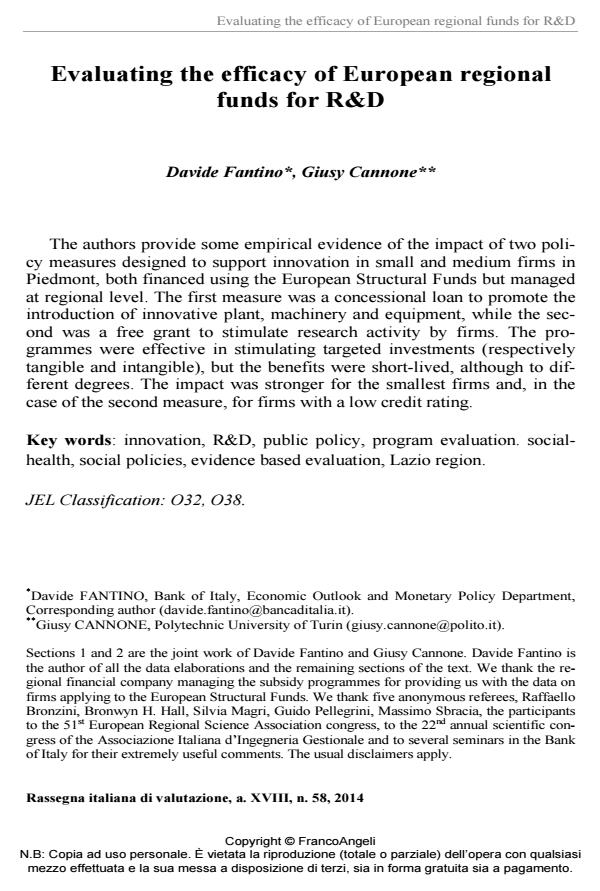Evaluating the efficacy of European regional funds for R&D
Titolo Rivista RIV Rassegna Italiana di Valutazione
Autori/Curatori Davide Fantino, Giusy Cannone
Anno di pubblicazione 2015 Fascicolo 2014/58 Lingua Inglese
Numero pagine 32 P. 165-196 Dimensione file 272 KB
DOI 10.3280/RIV2014-058008
Il DOI è il codice a barre della proprietà intellettuale: per saperne di più
clicca qui
Qui sotto puoi vedere in anteprima la prima pagina di questo articolo.
Se questo articolo ti interessa, lo puoi acquistare (e scaricare in formato pdf) seguendo le facili indicazioni per acquistare il download credit. Acquista Download Credits per scaricare questo Articolo in formato PDF

FrancoAngeli è membro della Publishers International Linking Association, Inc (PILA)associazione indipendente e non profit per facilitare (attraverso i servizi tecnologici implementati da CrossRef.org) l’accesso degli studiosi ai contenuti digitali nelle pubblicazioni professionali e scientifiche
The authors provide some empirical evidence of the impact of two policy measures designed to support innovation in small and medium firms in Piedmont, both financed using the European Structural Funds but managed at regional level. The first measure was a concessional loan to promote the introduction of innovative plant, machinery and equipment, while the second was a free grant to stimulate research activity by firms. The programmes were effective in stimulating targeted investments (respectively tangible and intangible), but the benefits were short-lived, although to different degrees. The impact was stronger for the smallest firms and, in the case of the second measure, for firms with a low credit rating.
Keywords:Innovation, R&D, public policy, program evaluation. socialhealth, social policies, evidence based evaluation, Lazio region.
Jel codes:O32, O38
- Almus M., Czarnitzki D. (2003). The Effects of Public R&D Subsidies on Firms’ Innovation Activities: The Case of Eastern Germany. Journal of Business and Economic Statistics, 21(2): 226-236. DOI: 10.1198/07350010328861891
- Arrow K.J. (1962). Economic Welfare and the Allocation of Resources for Invention. In: Nelson R., editor, The Rate and Direction of Inventive Activity. Princeton University Press.
- Blundell R., Costa Dias M. (2000). Evaluation Methods for Non-Experimental Data. Fiscal Studies, 21(4): 427-468. DOI: 10.1111/j.1475-5890.2000.tb00031.
- Bronzini R., de Blasio G. (2006). Evaluating the Impact of Investment Incentives: the Case of Italy’s Law 488/1992. Journal of Urban Economics, 60: 327-349. DOI: 10.1016/j.jue.2006.03.00
- Bronzini R., Iachini E. (2014). Are Incentives for R&D Effective? Evidence from a Regression Discontinuity Approach. American Economic Jornal: Economic Policy, forthcoming.
- Bronzini R., Piselli P. (2014). The Impact of R&D Subsidies on Firm Innovation. Temi di Discussione Banca d’Italia n. 960.
- Busom I. (2000). An Empirical Evaluation of the Effects of R&D Subsidies. Economics of Innovation and New Technology, 9(2): 111-148. DOI: 10.1080/1043859000000000
- Carmignani A., D’Ignazio A. (2011). Financial Subsidies and Bank Lending: Substitutes or Complements? Micro Level Evidence from Italy. Temi di Discussione Banca d’Italia n. 803.
- Cariola M., Calabrese G., Rolfo S. (2000). “Principi teorici ed evidenze empiriche nella valutazione delle politiche per l’innovazione delle regioni italiane”, Torino, III Convegno Nazionale AIV, 23-25 March.
- Dehejia R. H., Wahba S. (2002). Propensity Score-Matching Methods for Nonexperimental Causal Studies. The Review of Economics and Statistics, 84(1): 151-161. DOI: 10.1162/00346530231733198
- Duguet E. (2003). Are Subsidies a Substitute or a Complement to Privately Funded R&D? Evidence from France using Propensity Score Methods for Non-experimental Data. Université de Paris I Working Paper n. 75/2003.
- Evangelista R. (2007). Rilevanza e impatto delle politiche dell’innovazione in Italia. Prime indicazioni fornite dalle indagini CIS. Economia e politica industriale, 1: 103-124.
- Frolich M. (2004). Finite-Sample Properties of Propensity-Score Matching and Weighting Estimators. The Review of Economics and Statistics, 86(1): 77-90. DOI: 10.1162/00346530432302369
- Gabriele R., Zamarian M., Zaninotto E. (2007). “Assessing the Economic Impact of Public Industrial Policies: An Empirical Investigation on Subsidies”, mimeo.
- Hall B.H. (2002). The Financing of Research and Development. Oxford Review of Economic Policy, 18(1): 35-51. DOI: 10.1093/oxrep/18.1.3
- Hatzichronoglou T. (1997). Revision of the High-Technology Sector and Product Classification. OECD Science, Technology and Industry Working Papers 1997/2.
- Hussinger K. (2008). R&D and Subsidies at the Firm Level: An Application of Parametric and Semi-Parametric Two-Step Selection Models. Journal of Applied Econometrics, 23: 729-747. DOI: 10.1002/jae.1016IMF(2003).ExternalDebtStatistics:GuideforCompilersandUsers
- Lach S. (2002). Do R&D Subsidies Stimulate or Displace Private R&D? Evidence from Israel. The Journal of Industrial Economics, 50(4): 369-390. DOI: 10.1111/1467-6451.0018
- Lööf, H., Heshmati A. (2007). The Impact of Public Funds on Private R&D Investment: New Evidence from a Firm Level Innovation Study. In: Heshmati A., Sohn Y-B., Kim Y-R., editors, Commercialization and Transfer of Technology: Major Country Case Studies. Nova Science Publishers.
- OECD (2007). OECD Science, Technology and Industry Scoreboard.
- Wallsten S.J. (2000). The Effect of Government-industry R&D Programs on Private R&D: the Case of Small Business Innovation Research Program. The RAND Journal of Economics, 31(1): 82-100.
- Critical Information Infrastructures Security Isabelle Fries, Maximilian Greiner, Manfred Hofmeier, Razvan Hrestic, Ulrike Lechner, Thomas Wendeborn, pp.119 (ISBN:978-3-031-35189-1)
Davide Fantino, Giusy Cannone, Evaluating the efficacy of European regional funds for R&D in "RIV Rassegna Italiana di Valutazione" 58/2014, pp 165-196, DOI: 10.3280/RIV2014-058008